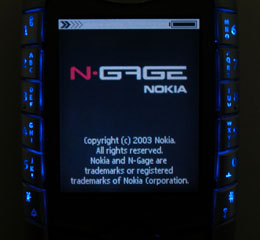I went to Brent Cross (Shopping Centre) on Saturday to speak to the people demonstrating the Reebok CyberRider. It was setup in the centre space, which I had remember from my youth as being a fountain. Four CyberRiders, two Playstations enabling riders to compete against each other.
After chatting for a while to one of the Reebok representatives, Grant Miller from The Body Squad, I decided to have a go, I found one of the Burnout games playing and I’ve got to say it was an interesting experience.
You start off thinking you’re turning the peddles a lot to stay up with the pack of other cars, but then you get absorbed in playing the game as you steer the car around the circuit. The two keys I used to steer the car were in a natural position and easy to operate. The other buttons felt a bit fiddly and could be prone to stick.
If you’re interested, I came second (I’ve no idea of the difficulty setting, but I suspect it was pretty lowly). By the time I realised I was doing OK, the first car was well ahead of me and I might have been able to catch it, thrashing silly in my home, but didn’t really feel like doing it in the middle of Brent Cross.
What they’ve come up with is an interesting idea, by combining what would normally be regarded at polar opposites, physical activity and playing video games, they created something where you exercise without thinking you’re exercising.
Of course that was just one title and the experience with other games might be completely different. I would be interested to try Tour de France, as Grant had. I’ve yet to play it at all but I remember some of the press labelled it a bit slow – perfect for the CyberRider. Could the future of the ‘sponsored run’ be sponsoring someone to actually cycle the Tour de France and you pay them according to their position in the race?
I was having a mental flick through of various types of games and I thought a Doomesque game would be fun, where you have to peddle for your life – it would be perfect if you could peddle backwards as well … and have triggers. For a more relaxing session a title like Pilot Wings on the N64, where the controls aren’t too complex but you have to peddle to stay in the sky. On the retro side, save bashing your Track and Field keys into oblivion and replace it with peddling.
The trick that they appear to be currently missing is to have the resistance of the peddling varied by the computer, so you’d have to push hard up hills. This would introduce a lot more variety and would make driving games set in San Francisco a pretty serious workout.
Personally, I’d like to see the ability to change the sensitivity of the peddle sensor, so the ride wouldn’t have to be totally manic to win the race. Or is that defeating the purpose?
If you were wondering about my stress levels at Brent cross – it actually wasn’t that bad at the beginning, but I’m sure there’s something they must put in the air conditioning system that means that you get a growing feeling that you’ve just godda get out of that place.
___The Tech
They altered a standard bike by integrating joypad buttons of differing sizes into the riding handles, fitted a sensor at the peddles and strengthened it slightly – after finding the competition got pretty hot between the testers.
The hardware is modular. Two cables use RJ45 connectors to the box that interfaces to the console/computer, enabling them to connect to any device. They’ve currently connected to PlayStation 2 & 1 and PC. They say that GameCube and XBox are in the works.
___Conclusions
Bearing in mind that I had the limited exposure of one game, I thought it was fun and for a lot of people who don’t exercise this could be the excuse they’re looking for – especially if they like gadgets.
It’s unlikely people are going to buy more than one of these (and console, and TV) so after trying it, I’m even more convinced that the long term future for this type of thing, as I said previously, will be linking them up with broadband – s not something they’d tried.
I also suggested that it would be fun to equip a number of gyms, get them connected together and have people compete against each other. Find the fittest gym.
 If true, the impact is far reaching. Games written for the N-Gage will run on any phone running the Symbian operating system and according to Symbian, over 2.68 million handsets were shipped with their OS in the first half of 2003.
If true, the impact is far reaching. Games written for the N-Gage will run on any phone running the Symbian operating system and according to Symbian, over 2.68 million handsets were shipped with their OS in the first half of 2003. After a number of months of speculation, Sony have released the full details the PSX. Combining the ability to play PlayStation games with a television tuner, PVR, ATRAC3/MP3 playback and a DVD player/recorder, the box will also be equipped with a 100Mb Ethernet port – opening the door to the delivery of digital media.
After a number of months of speculation, Sony have released the full details the PSX. Combining the ability to play PlayStation games with a television tuner, PVR, ATRAC3/MP3 playback and a DVD player/recorder, the box will also be equipped with a 100Mb Ethernet port – opening the door to the delivery of digital media.